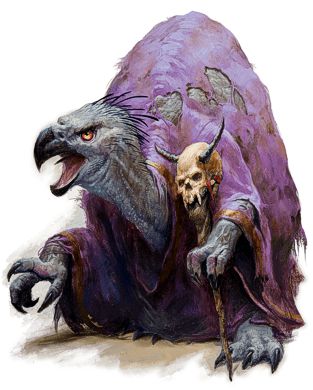

MC Mystara Appendix • Dragon #339

| Climate/Terrain: | Nonarctic desert, ruins |
|---|---|
| Frequency: | Very rare |
| Organization: | Solitary |
| Activity Cycle: | Any |
| Diet: | Omnivore |
| Intelligence: | Exceptional (15-16) |
| Treasure: | I |
| Alignment: | Chaotic neutral |
| No. Appearing: | 1 |
| Armor Class: | 3 |
| Movement: | 12 |
| Hit Dice: | 9 |
| THAC0: | 11 |
| No. of Attacks: | 1 |
| Damage/Attack: | 1d8 (staff) |
| Special Attacks: | Spells |
| Special Defenses: | Nil |
| Magic Resistance: | 15% |
| Size: | M (5-6’ tall) |
| Morale: | Elite (13) |
| XP Value: | 3,000 |
Nagpas resemble dried, withered humans with the heads of vultures. They are intelligent, magical creatures that shun the company of other races.
Nagpas stand 5 to 6 feet tall. Their skin is brownish and similar to mummified human skin, and their joints appear to be gnarled with age. A strange odor surrounds them; it smells like a combination of bird droppings, mustiness, dust, and old chemicals left on a wizard’s shelf too long.
Nagpas speak the Common tongue as well as their own language called Nag (pronounced NAWC). Nag consists of squawks, caws, and shrieks, and is definitely not a language suited for whispering or polite conversation.
Combat: As a rule, nagpas shun contact. They prefer to hide or flee rather than contend with outsiders. When forced into combat, nagpas use long-range spells first to try to end the fight as quickly as possible. If the opponents are not driven off, nagpas increase the deadliness of spells or enter melee combat.
These highly magical creatures use spells that are equivalent to the spells of a 9th- to 12th-level mage. Before an encounter with a nagpa, the DM rolls 1d4+8 o determine the creature’s spell level, then chooses the nagpa’s spells. Nagpas cast spells just like normal wizards; that is, the spells must be memorized, and the spells use verbal, somatic, and material components.
In addition to their spells, nagpas have innate powers, each of which can be used up to three times per day:
If forced into physical combat, nagpas can swing their heavy staffs as melee weapons. A nagpa’s staff is made of an odd combination of iron and wood; both elements appear to be swirled together in a smooth mixture. The staff causes 1d8 points damage in the capable hands of a nagpa. If used by anyone else, the staff inflicts only 1d6 points of damage (the same as a normal quarterstaff).
The nagpa’s staff also functions as a ring of spell storing. It can store a total of three spells of levels 1 through 3. This function can be used by creatures other than the nagpa. Spells are cast from the staff at the 8th level of ability.
Though the attack is not noted above, nagpas bite with their beaks as a desperate last resort. The bite inflicts 1d8 points of damage with a successful attack.
Habitat/Society: No one has ever seen a nagpa offspring or a nagpa family, and with good reason; there are none. Perhaps half a dozen people in the world know the truth about these odd creatures. Nagpas are, or rather were, human or half.elven mages cursed with this disfigurement and set loose to wander the length and breadth of Mystara. Certain Immortals inflict this curse upon especially selfish mages who disdain the company of others. The curse cannot be removed by any spell less powerful than a wish.
As part of their curse, nagpas instinctively know if they are being talked about anywhere within a 100-mile radius. They can track such gossipers as long as the speakers remain in range.
A nagpa’s ears suffer a burning sensation that grows hotter as the nagpa gets closer to the individual who spoke about the race. Items such as amulets of nondetection protect speakers from the cursed detection of the nagpas. So great is the nagpas’ shame that they are determined that none should ever know their horrible secret. When a speaker is found, he or she is immediately killed by the nagpa. It then wanders away, consumed with feehgs of guilt, remorse, relief, and joy.
Ecology: These cursed creatures cannot eat, sleep, laugh, reproduce, or take part in any other activity enjoyed by living humans. Some evil mages use the skin of nagpas as parchment for scrolls of certain powerful necromantic spells.
